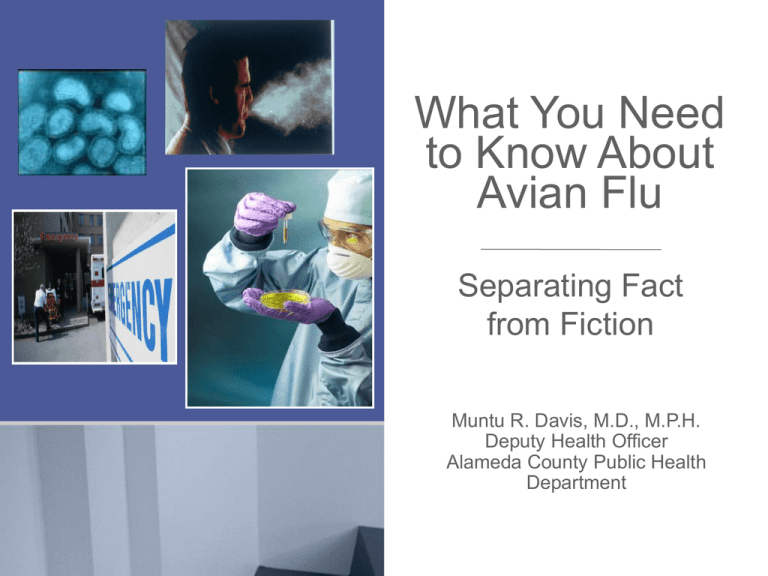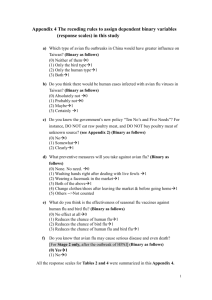What You Need to Know About Avian Flu
advertisement

What You Need to Know About Avian Flu Separating Fact from Fiction Muntu R. Davis, M.D., M.P.H. Deputy Health Officer Alameda County Public Health Department Commonly Used Terms Term Law Enforcement Public Health Case A body of evidence A person with the disease of interest Suspect A person under suspicion A person who may be a case Surveillance Watching individuals Tracking disease Proof of a crime Information used to identify and/or to treat disease Evidence What is avian influenza? (Also known as avian flu or ‘bird flu’) An infection caused by viruses that normally cause disease in birds, e.g., waterfowl, shorebirds or poultry (chickens, ducks, and turkeys), and, less commonly, in pigs. • What is so special about the current outbreaks of avian flu in poultry? Largest and most severe on record Many countries affected simultaneously Avian influenza A (H5N1), especially difficult to control 150 million birds dead or destroyed, but virus now considered endemic (occurring within a specific area or region) Spreading due to bird migration patterns Do bird flu viruses infect people? Not usually. However, a growing number of cases of human infection with bird flu viruses, mainly in Southeast Asia, have occurred since 1997. How do people become infected? Outbreak of avian flu in poultry (chicken, ducks, turkeys) plus Contact with infected poultry or surfaces contaminated with excretions from infected birds means Possible risk of avian flu to person What about eating chicken and eggs? To date, no studies have linked any human cases of avian flu to eating poultry products. • What are the symptoms of bird flu in people? Fever Cough Typical flu-like symptoms Sore throat Muscle aches Eye infections Difficulty breathing due to pneumonia Other severe and life-threatening complications Is it here yet? No. There has been no detection of the H5N1 virus found in Asia and Europe and no human cases of avian flu in the United States to date. So, why all of the attention and fear? Reason #1: Overlap of bird migratory flyways with outbreak areas Reason #2: Influenza pandemics have happened in the past ‘Spanish flu’, 1918-19, caused by H1N1 ‘Asian flu’, 1957-58, caused by H2N2** ‘Hong Kong flu’, 1968-69, caused by H3N2** • ** These were caused by new viruses, containing both human and avian genes. Influenza Pandemic Appearance of new influenza virus in humans to which the human population has little or no immunity Ability of the virus to replicate and cause disease in large numbers Spreads easily from person-toperson Spread to another continent The 1918 influenza virus infected ~30% of the world's population and killed up to 40 million individuals, particularly young people Reason #3: Avian influenza A (H5N1) virus new to humans All prerequisites for a pandemic to start except human-to-human transmission More severe and difficult to control than most avian strains New animals infected for first time Little or no immunity in humans Ducks have virus with no symptoms, but excrete virus, so sustainable reservoir Human cases concentrated in previously healthy children and young adults Reason #4: Viral gene re-assortment Re-assortant virus Will the flu shot protect from bird flu? There is no vaccine currently to protect from bird flu. • However, flu shots will protect you from common influenza viruses that commonly cause severe flu in people. • **Ask your doctor about if you should get a flu shot. • What about the pneumonia shot? This is for pneumonia caused by certain bacteria, not viruses. • However, pneumonia shots will protect you from 23 of the most common types of Streptococcus pneumonia bacteria, which cause pneumonia, blood poisoning and meningitis. • **Ask your doctor about if you should get a pneumonia shot. • What if I had pneumonia before? Again, this is a new virus to humans and, therefore, the general population will have little or no immunity to it. • What should travelers do when traveling to infected countries? Know the signs and symptoms of bird flu. Get up-to-date vaccinations. Get a physical check-up at least 4 weeks prior to travel. Practice good hygiene; wash your hands frequently with soap and water. Avoid poultry farms and live animal markets. Do not feed pigeons or other birds. Wash your hands immediately after contact with birds or poultry. Do not eat undercooked poultry. Do not eat raw eggs or dip cooked food into any sauce containing raw eggs. Listen to the news and stay informed if there is an outbreak. • After you return from your travel: Monitor your health for 10 days. If you develop flu-like symptoms within 10 days of your return, call your doctor. It is important to tell your doctor that you have recently traveled to a country with a known bird flu outbreak. Sources: Centers for Disease Control, World Health Organization, The Center for Health and Health Care in Schools Public Health Resources for an Influenza Pandemic Public Health Departments Help educate about diseases, diagnosis and treatment Epidemiologists Disease surveillance (study disease, find source and characteristics) and track new cases Scientists Identify agents and provide technical information Stay informed! Visit these websites for more information about Avian Flu. • • Centers for Disease Control (CDC): http://www.cdc.gov/flu/avian/ World Health Organization: http://www.who.int/csr/disease/avian_influenza/en/ CDC Notice to Travelers: http://www.cdc.gov/travel/other/avian_influenza_se_as ia_2005.htm Thank you ! Questions?







